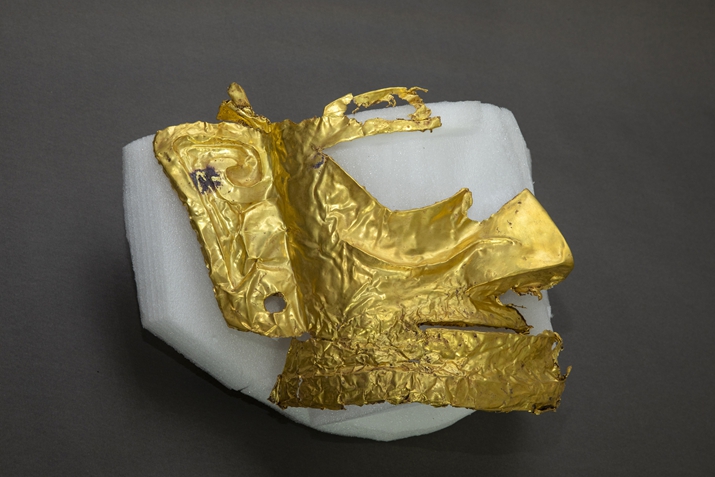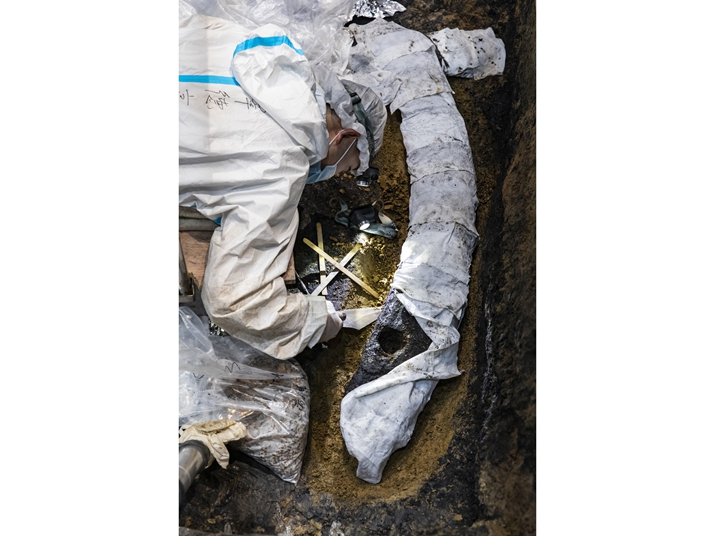|
||||||||||
| Home Nation World Business Opinion Lifestyle ChinAfrica Multimedia Columnists Documents Special Reports |
|
||||||||||
| Home Nation World Business Opinion Lifestyle ChinAfrica Multimedia Columnists Documents Special Reports |
| ChinAfrica |
| New findings at Sanxingdui Ruins shed light on ancient Chinese culture |
| In late March, Chinese archaeologists announced major new discoveries at the legendary Sanxingdui Ruins site located on the upper reaches of the Yangtze River, helping shed light on the cultural origins of the Chinese nation. After sleeping for 3,000 years, the "awakening" of these relics has shocked the world |
| By Xia Yuanyuan VOL. 13 MAY 2021 ·2021-05-21 |

A broken gold mask unearthed from a sacrificial pit at the Sanxingdui Ruins site is on display on March 17 (XINHUA)
In late March, Chinese archaeologists announced major new discoveries at the legendary Sanxingdui Ruins site located on the upper reaches of the Yangtze River, helping shed light on the cultural origins of the Chinese nation. After sleeping for 3,000 years, the "awakening" of these relics has shocked the world.
Archaeologists have found six new sacrificial pits and unearthed more than 500 items dating back about 3,000 years at the Sanxingdui Ruins, the National Cultural Heritage Administration announced in Chengdu, Sichuan Province in southwest China.
The cultural items, unearthed from four pits, include pieces of gold masks, gold foil, bronze masks, bronze trees, jade, textiles and a large number of ivories. Pieces of miniature ivory sculptures, carbonized rice and seeds of trees were also excavated.
The site of Sanxingdui, located in the city of Guanghan, 40 km from Chengdu, is recognized as one of the most important archaeological sites in the world for its vast size and rich cultural contents.
The site was first discovered in 1929 by Yan Daocheng, a villager who accidentally uncovered jade and stone artworks when digging a ditch, and archaeological excavation has continued ever since. During this period, generations of archaeologists have worked on the discovery and research of the Sanxingdui culture. The remnants are believed to belong to Shu Kingdom, dating back at least 4,800 years and lasting over 2,000 years.

An archaeologist cleans and excavates ivory at the Sanxingdui site in Guanghan, Sichuan Province, on March 17 (XINHUA)
In 1986, two major pits - No. 1 and No. 2 pits - were found accidentally, and they aroused widespread academic interest around the world. The pits are widely believed to have been sites of sacrificial ceremonies. Over 1,000 artifacts featuring abundant bronze ware with exotic appearance and gold artifacts indicating royal power were found at that time.
Lei Yu, a researcher at the Sichuan Provincial Cultural Relics and Archaeology Research Institute, said the recent discoveries further confirm the theory that the pits were used for sacrificial purposes, as many of the items found had been smashed and burned before being buried.
Archaeologists also say the new discoveries show the Shu civilization was part of the ancient Chinese civilization. For example, the excavation found a large number of bronze wine cups and the carving design on the ivory looks like Chinese carved patterns. Some of the bronze items have been decorated with dragon and ox patterns. Besides, in the No. 3 pit, archaeologists found two square zun jars, a typical ancient Chinese bronze ritual vessel for holding water or wine.
"The relics unearthed at Sanxingdui shed light on the diverse, unified origin of the Chinese civilization. The ancient Shu culture and the culture along the Yangtze River made great contributions to the ancient Chinese culture," said Song Xinchao, Deputy Director of the National Cultural Heritage Administration.
Archaeologists widely used cutting-edge technologies in the excavation and research. At the excavation site, a protective climate-controlled building, nearly 2,000 square meters in size, covers the entire excavation area for the sacrificial pits. Different types of hi-tech equipment are also being utilized during the excavation of the Sanxingdui Ruins, including hyperspectral remote sensors and 3D scanning, for the better conservation of the relics.
(Print Edition Title: Unearthing Civilization)
Comments to xyy@chinafrica.cn
| About Us | Contact Us | Advertise with Us | Subscribe |
| Copyright Beijing Review All rights reserved 京ICP备08005356号-5 京公网安备110102005860号 |